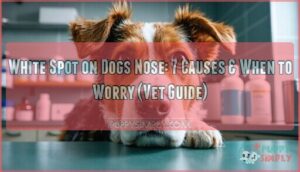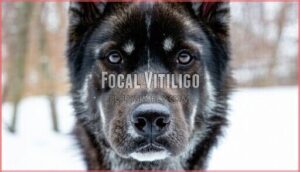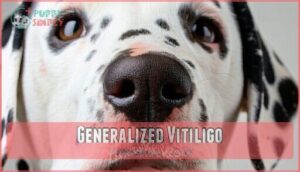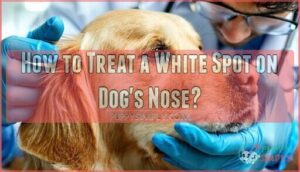This site is supported by our readers. We may earn a commission, at no cost to you, if you purchase through links.
 A white spot on your dog’s nose usually isn’t something to lose sleep over.
A white spot on your dog’s nose usually isn’t something to lose sleep over.
Most cases stem from harmless causes like vitiligo, where your pup simply loses pigmentation as they age.
"Snow nose" is another common culprit that causes seasonal color changes in certain breeds.
Sometimes it’s just a whitehead or minor skin irritation from rubbing their nose against surfaces.
However, watch for red flags like rapid growth, texture changes, or discomfort.
While cancer is rare, it’s worth checking with your vet if the spot seems unusual.
Understanding the difference between normal aging and concerning symptoms helps you make the right call.
Table Of Contents
- Key Takeaways
- Causes of Vitiligo in Dogs and Cats
- Types and Symptoms of Vitiligo
- Diagnosis of Vitiligo
- Treatment and Management of Vitiligo
- White Spot on Dog’s Nose: Possible Reasons
- How to Treat a White Spot on Dog’s Nose?
- Is a White Spot on Dog’s Nose a Sign of Cancer?
- Frequently Asked Questions (FAQs)
- How do you treat snow nose in dogs?
- What do spots on a dog’s nose mean?
- What does a white spot on your dog mean?
- What does kennel nose look like?
- Is vitiligo contagious in dogs and cats?
- Are there any home remedies for vitiligo in pets?
- Is there any way to prevent vitiligo in pets?
- Is there a difference between a white spot on a dog’s nose and vitiligo?
- What are the long-term effects of vitiligo in pets?
- Can white spots on dog noses spread?
- Conclusion
Key Takeaways
- Most white spots aren’t serious – You’ll typically see harmless causes like vitiligo (age-related pigment loss), snow nose (seasonal color changes), or simple whiteheads from skin irritation.
- Watch for warning signs – You should contact your vet if the spot grows rapidly, changes texture, bleeds, or causes your dog discomfort, as these could indicate more serious conditions.
- Treatment depends on the cause – You can manage most cases with gentle home care like moisturizing balms, but autoimmune conditions or infections need professional veterinary treatment.
- Cancer is rare but possible – While less than 2% of dogs develop nasal cancer, you shouldn’t ignore persistent bumps, unusual discharge, or bleeding that won’t heal.
Causes of Vitiligo in Dogs and Cats
Vitiligo in dogs stems from several root causes that work together like puzzle pieces.
Like a medical mystery, vitiligo pieces together genetics, immunity, and environment to create those distinctive white patches.
Genetic predisposition plays a major role – certain breeds carry higher breed susceptibility to this autoimmune disorder.
Your dog’s immune system mistakenly attacks melanocytes, causing melanocyte damage and those telltale white patches.
Environmental triggers like stress, infections, or chemical exposure can flip the switch on this condition.
Immune factors basically turn your pet’s defense system against itself, creating an autoimmune disease that affects pigment production permanently.
Types and Symptoms of Vitiligo
You’ll see two main types of vitiligo in dogs based on how much of their body gets affected.
Focal vitiligo stays in one spot like the nose, while generalized vitiligo spreads to many areas including paws, face, and other body parts.
Focal Vitiligo
When focal vitiligo in dogs zeroes in on one specific area, it creates concentrated patches of white skin where pigment cells have disappeared.
This targeted form of canine vitiligo often shows up first on your dog’s nose, creating that telltale dog nose white spot you might notice during grooming.
Here’s what makes focal vitiligo unique:
- Nose-Specific Vitiligo – The nose becomes the primary target area
- Breed Predisposition – Certain breeds like Huskies and Labs face higher risks
- Cosmetic Concerns – Changes appearance but doesn’t affect health
- Differential Diagnosis – Requires vet testing to rule out other conditions
- Progression Speed – Develops slowly over months or years
Dog nose depigmentation from focal vitiligo stays contained rather than spreading across your pet’s entire body like other forms.
Generalized Vitiligo
While focal vitiligo stays in one spot, generalized vitiligo spreads across your dog’s body like spilled paint.
This form affects multiple areas including the nose, paws, and coat.
Your pup’s immune response mistakenly attacks melanocytes, causing widespread dog nose depigmentation and beyond.
Genetic predisposition plays a big role here.
Some breeds face higher risks due to their DNA makeup.
The disease progression varies between dogs – some develop patches slowly while others see rapid changes.
| Aspect | Details |
|---|---|
| Affected Areas | Nose, paws, eyelids, coat |
| Melanocyte Destruction | Widespread immune attack |
| Breed Variations | Genetic differences affect severity |
| Dog Autoimmune Diseases | Often linked to other conditions |
Canine vitiligo requires careful monitoring as it progresses unpredictably across your pet’s body.
Diagnosis of Vitiligo
Getting to the bottom of your dog’s white spots requires detective work from your vet. They’ll start with a thorough examination, checking your pup’s medical history and looking for breed predisposition patterns.
Since several conditions can mimic vitiligo, differential diagnosis becomes vital. Your veterinarian will likely recommend specific diagnostic tests to rule out other dog nose white spot causes.
While some cases seem obvious, confirming canine vitiligo through proper veterinary diagnosis guarantees you’re not missing something serious. The diagnostic process typically includes:
- Physical examination of affected areas and overall skin condition
- Medical history review focusing on when symptoms first appeared
- Skin scraping to check for infections or parasites
- Blood tests to identify underlying autoimmune conditions
- Skin biopsy for pigment cell analysis and definitive diagnosis
These tests help distinguish vitiligo from conditions like fungal infections, autoimmune diseases, or even cancer, giving you peace of mind about your dog’s condition. Senior dogs may also experience decline of olfactory receptors, which can complicate diagnosis.
Treatment and Management of Vitiligo
You can’t cure vitiligo in dogs, but you can manage it with simple steps that help slow the spread and keep your pet comfortable.
The treatment focuses on reducing stress, adding sun exposure, treating other health problems, and giving supplements like omega-3 fatty acids.
The goal is to help slow the spread and keep your pet comfortable.
Increasing Sun Exposure
Once you’ve confirmed vitiligo through proper diagnosis, controlled sun exposure can help restore your dog’s nose pigmentation.
UVB benefits include stimulating melanin production, which may reduce dog nose discoloration over time. However, breed sensitivity matters – light-colored dogs face higher sunburn risks.
Start with gradual exposure, just 10-15 minutes daily during mild morning hours. Monitor for dog nose color change improvements while watching for redness or irritation.
This natural approach works best when your dog’s nose losing pigment stems from vitiligo rather than other conditions. Consider using allergy-friendly shampoos to avoid further skin irritation during bathing.
Treating Underlying Medical Conditions
When blood tests reveal medical causes behind your dog’s nose discoloration, targeted treatment becomes essential.
Your vet will address the root problem through specific approaches:
- Autoimmune Therapies – Anti-inflammatory medications for autoimmune disorder cases
- Infection Management – Antibiotics when bacterial infections trigger pigment loss
- Cancer Treatment – Specialized protocols if tumors cause nose changes
Treatment options vary based on your dog’s specific diagnosis.
Some breeds are genetically predisposed to nasal dermatoses, which can also cause nose discoloration.
Reducing Stress
Beyond treating medical conditions, your dog’s mental wellbeing plays a big role in nose health.
Stress can worsen skin conditions and slow healing.
Create a peaceful home environment with consistent routines and plenty of exercise.
Mental stimulation through puzzle toys keeps anxious minds busy.
| Stress Reducer | Daily Action | Benefit |
|---|---|---|
| Calming Techniques | Gentle massage, soft music | Lowers cortisol levels |
| Exercise Benefits | 30-minute walks | Releases natural mood boosters |
| Social Interaction | Playdates with other dogs | Reduces isolation anxiety |
Tattooing Depigmented Areas (Cosmetic Option)
Some pet owners consider tattooing as a cosmetic solution for depigmented areas on their dog’s nose. This procedure involves applying black ink to restore the natural appearance of pigmentation affected by vitiligo or snow nose conditions.
While it can address cosmetic concerns, several factors need careful consideration:
- Tattooing Risks: Potential complications include infection, allergic reactions, and skin irritation
- Color Matching: Achieving natural-looking results requires precise pigmentation matching techniques
- Procedure Cost: Professional tattooing can be expensive and may require multiple sessions
The longevity factors vary, and ethical considerations around unnecessary cosmetic procedures should guide your decision-making process.
Vitiligo, a condition that causes skin depigmentation in pets, is often the underlying cause for these cosmetic concerns.
Dietary Supplements (Omega-3 Fatty Acids and Vitamin C)
Adding dietary supplements to your dog’s routine can support their skin health and potentially slow vitiligo progression.
Omega-3 fatty acids offer significant benefits for maintaining coat improvement and supporting immune function.
Fish oil supplements work best when mixed into your dog’s food daily.
These healthy fats help preserve dog nose pigmentation while promoting overall dog skin care.
You can find various dog omega 3 products online for your pet.
Vitamin C also plays a vital role in managing vitiligo symptoms.
However, determining the right Vitamin C dosage requires veterinary guidance since dogs produce their own vitamin C naturally.
Your vet will consider supplement interactions with any existing medications your pet takes.
Both supplements support dog nose health by strengthening the immune system and maintaining skin integrity.
While these additions won’t cure vitiligo, they’re valuable tools in thorough dog care.
Always consult your veterinarian before starting any supplement regimen to confirm proper dog health management.
White Spot on Dog’s Nose: Possible Reasons
If you’ve spotted a white mark on your dog’s nose, you’re probably wondering what caused it and whether you should worry.
The good news is that most white spots are harmless conditions like pimples, seasonal color changes, or minor skin irritation from rubbing against surfaces.
Whiteheads or Pimples
Just like teenagers get breakouts, dogs can develop dog nose pimples and whiteheads too.
These dog nose breakouts happen when clogged follicles trap dirt and oil around your pup’s muzzle.
Poor bowl hygiene often triggers puppy acne – dirty food and water dishes create the perfect breeding ground for bacteria.
You’ll spot small, raised white bumps that look similar to human whiteheads.
Dog nose clogged pores are especially common in young dogs going through hormonal changes.
Genetic predisposition can also be a factor.
Without proper care, these spots can lead to secondary infections that require veterinary attention.
Clean feeding bowls daily and consider topical treatments if breakouts persist.
Most dog nose whiteheads clear up naturally, but monitor them closely for signs of infection or spreading.
Snow Nose Condition
Snow nose affects your dog’s nasal pigmentation through seasonal pigmentation changes.
This reversible hypopigmentation causes your dog’s nose to lose its dark color, turning pink or white during colder months.
Snow nose dogs include Labrador Retrievers, Golden Retrievers, and Siberian Huskies due to breed predisposition.
The condition isn’t harmful—it’s simply reduced melanin production triggered by shorter daylight hours.
Sunlight exposure often helps restore normal pigmentation when warmer weather returns.
Your vet might recommend diagnostic exclusion to rule out autoimmune conditions like discoid lupus.
Dog nose pigmentation changes from snow nose are purely cosmetic and don’t require treatment.
Kennel Nose
Kennel nose develops when your dog rubs their nose against crate bars or kennel walls repeatedly. This condition creates raw, sore patches that can appear white or pink. Dogs with separation anxiety often develop kennel nose from persistent rubbing behaviors.
Warning signs that demand immediate attention:
- Bleeding or open wounds – Your dog’s nose shows active bleeding or deep cuts
- Spreading irritation – The raw area grows larger or spreads to other face areas
- Behavioral changes – Your dog stops eating or seems unusually distressed
- Infection signs – Pus, bad smell, or excessive swelling appears around the nose
Treatment focuses on prevention and homecare. Remove rough surfaces from your dog’s kennel and add soft bedding. Clean the area gently with warm water. Severity varies, but most dog nose lesions from kennel nose heal with proper dog nose care. Consider providing comfortable dog beds to minimize rubbing.
Nasal Hyperkeratosis
Nasal hyperkeratosis creates thick, crusty layers on your dog’s nose through excessive keratin buildup.
This condition mainly affects older dogs and certain breeds with genetic predispositions. The dry skin can crack, causing discomfort and reducing smell sensitivity.
| Aspect | Details | Management |
|---|---|---|
| Symptoms | Thick, crusty nose texture | Regular moisturizing |
| Causes | Keratin buildup, genetics | Address underlying issues |
| Treatment | Balms, gentle removal | Prevent cracks forming |
Home remedies include petroleum jelly applications, while severe cases need veterinary keratin removal.
You can find various treatment options online.
Canine Vitiligo
Canine vitiligo causes your dog’s nose to lose its dark pigment, creating white patches where melanin-producing cells have been destroyed.
This condition affects certain breeds more than others due to genetic factors, with Dachshunds, Dobermans, and German Shepherds showing higher breed predisposition.
The immune response mistakenly attacks pigment cells, leading to gradual pigment loss that typically starts around the nose.
While diagnostic challenges exist since vitiligo mimics other conditions, your vet can distinguish it through careful examination and testing.
Though there’s no cure for this depigmentation, it’s purely cosmetic and won’t harm your dog’s health or comfort.
How to Treat a White Spot on Dog’s Nose?
Your dog’s white spot treatment depends on the underlying cause. Start with gentle home remedies like dog nose moisturizer for dry skin, but vet intervention remains essential for proper diagnosis.
Here’s your action plan:
- Monitor the spot’s size and changes daily
- Apply dog-safe topical treatment as recommended
- Consider preventative measures like nose balm
- Schedule veterinary care for persistent spots
Professional dog nose treatment addresses serious conditions like autoimmune disorders. Insurance coverage often helps with diagnostic costs for dog nose skin conditions requiring specialized care.
Is a White Spot on Dog’s Nose a Sign of Cancer?
Cancer isn’t the first thing that comes to mind when you spot white patches on your dog’s nose, and for good reason. Most white spots stem from harmless conditions like snow nose or simple pimples.
Most white spots on your dog’s nose are completely harmless – cancer is rarely the culprit behind those mysterious patches.
However, nasal cancer does affect less than 2% of dogs, making it worth understanding the warning signs. Dog nose cancer symptoms include persistent bumps, unusual discharge, difficulty breathing, or bleeding that won’t heal.
Cancerous growth typically appears as irregular masses rather than smooth white spots. One potential cause of such symptoms could be nasal foreign bodies, which can lead to discomfort and discharge.
If you’re concerned, diagnostic options include physical exams, biopsies, and imaging tests. Tumor types affecting the nose range from benign growths to aggressive cancers.
Treatment costs vary widely depending on severity and chosen approach. Preventative measures include limiting sun exposure and regular vet checkups. When in doubt, trust your instincts and seek professional dog nose cancer diagnosis for peace of mind.
Frequently Asked Questions (FAQs)
How do you treat snow nose in dogs?
Snow nose can’t be treated or prevented since it’s a natural pigment change.
You don’t need to worry about it – it’s completely harmless and purely cosmetic, affecting your dog’s appearance but not their health.
What do spots on a dog’s nose mean?
Your pup’s nose isn’t sending Morse code, but those spots are definitely trying to tell you something.
They could signal anything from harmless aging or "snow nose" to infections requiring your vet’s attention, which is a critical aspect to consider for your pup’s health.
What does a white spot on your dog mean?
A white spot on your dog’s nose can mean several things.
It might be a harmless pimple, seasonal color change, or kennel rubbing.
Most aren’t serious, but persistent spots need veterinary attention.
What does kennel nose look like?
Like sandpaper on skin, kennel nose appears as raw, reddish patches where your dog’s nose has rubbed against crate bars.
You’ll notice worn-down skin that looks scraped or chafed, often accompanied by minor bleeding or scabbing, which can be described as raw and reddish patches.
Is vitiligo contagious in dogs and cats?
No, vitiligo isn’t contagious between dogs and cats.
It’s a genetic condition that causes pigment loss, creating white patches on your pet’s skin.
You can’t catch it from touching affected animals or sharing their space.
Are there any home remedies for vitiligo in pets?
Like chasing your own tail, searching for vitiligo home remedies won’t get you far.
There’s no cure or effective home treatment for this genetic condition.
Your vet can recommend supportive care, but vitiligo typically requires professional management.
Is there any way to prevent vitiligo in pets?
Unfortunately, you can’t prevent vitiligo in pets since it’s a genetic condition.
However, you can reduce stress, maintain good nutrition, and avoid harsh chemicals that might trigger or worsen existing vitiligo symptoms.
Is there a difference between a white spot on a dog’s nose and vitiligo?
Wondering if that spot means vitiligo?
Yes, there’s a difference.
A white spot can be many things—pimples, kennel nose, or infections.
Vitiligo specifically causes pigment loss and typically spreads beyond just one area.
What are the long-term effects of vitiligo in pets?
Your pet’s vitiligo won’t hurt them physically.
The white spots spread slowly over years but don’t cause pain or health problems.
It’s purely cosmetic, so your furry friend stays healthy and happy.
Can white spots on dog noses spread?
Yes, some white spots can spread.
Vitiligo often starts on your dog’s nose and may expand to paws or eyelids.
Autoimmune conditions like lupus can also spread to surrounding areas, requiring veterinary monitoring.
Conclusion
Remember, an ounce of prevention is worth a pound of cure regarding your dog’s health.
Most cases of a white spot on dogs nose are harmless conditions like vitiligo or snow nose that don’t require treatment. However, you shouldn’t ignore sudden changes, rapid growth, or signs of discomfort.
Regular check-ups with your vet help catch any serious issues early. Stay observant but don’t panic over every small change in your furry friend’s appearance.
- https://www.hillspet.com/dog-care/behavior-appearance/dog-snow-nose
- https://pubmed.ncbi.nlm.nih.gov/33981444/
- https://www.vet.cornell.edu/departments-centers-and-institutes/riney-canine-health-center/health-info/canine-skin-autoimmune-diseases
- https://www.umassmed.edu/lupus/blog/blog-posts/2021/lupus-in-dogs/lupus-in-dogs/
- https://vcahospitals.com/know-your-pet/discoid-cutaneous-lupus-erythematosus












